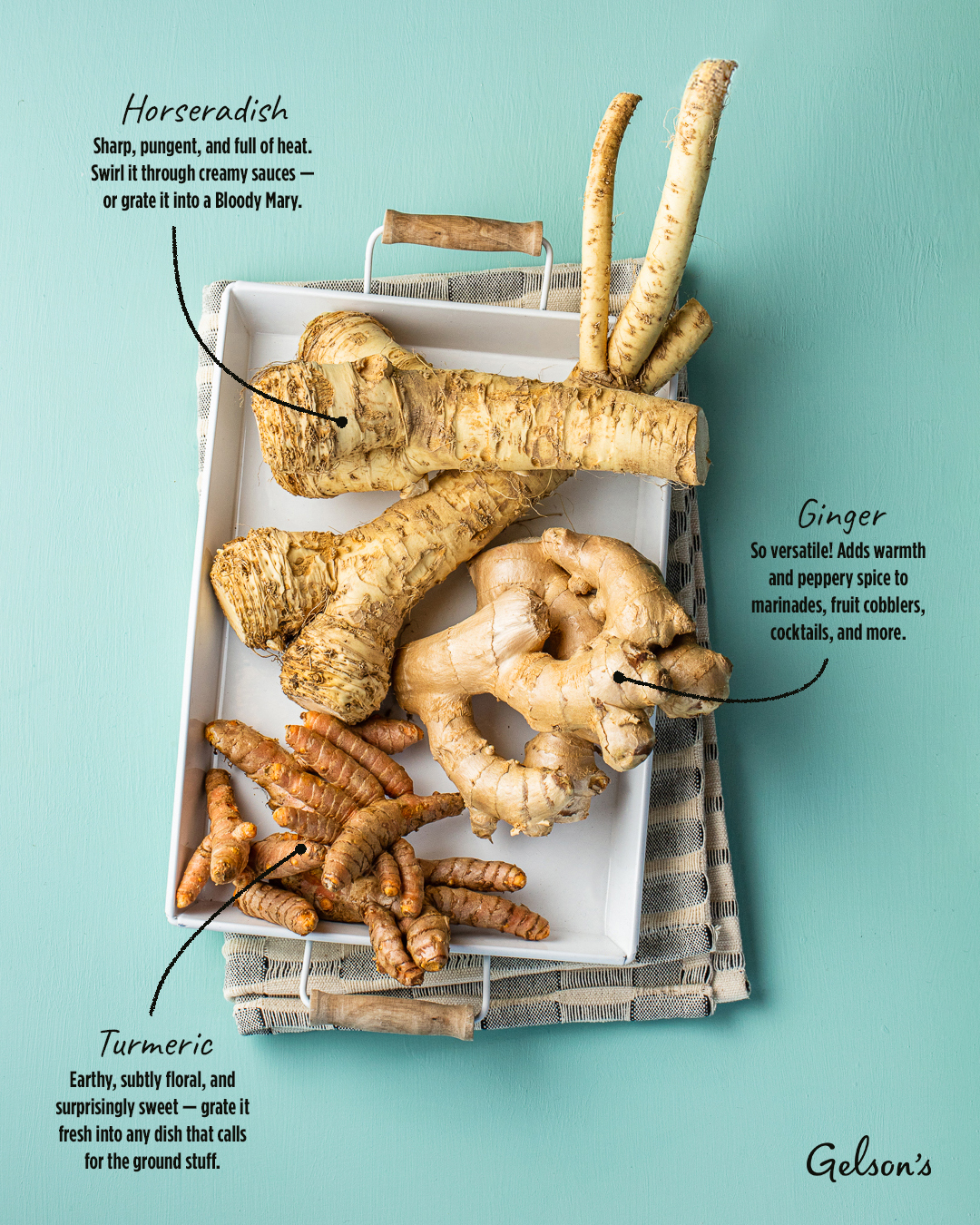Announcements
- Home /
- Announcements /
- A home cooks guide to aromatic roots
A Home Cook’s Guide to Aromatic Roots

We love digging into the world of roots. In fact, we’ve done it before — you might recall our Home Cook’s Guide to Root Vegetables. This time, however, we’re focusing on three of the most popular aromatic roots: horseradish, ginger, and turmeric.
These roots have been used in traditional medicines throughout history. For example, Pliny the Elder wrote about horseradish in his tome, Natural History, as a remedy for sores, mange, and ulcers. According to the 5th century writings of the Buddhist monk Faxian, Chinese sailors consumed ginger to stave off scurvy. And turmeric is used in Ayurvedic practices to relieve arthritis and improve energy levels.
But in the kitchen, horseradish, ginger, and turmeric roots act more like spices — bringing intense flavor, heat, and fragrance to our favorite foods. You might be thinking, why go to the trouble of fresh roots when there’s prepared horseradish and dried ginger and turmeric? The fresh versions bring so much more depth and complexity to a dish. And prepping these gnarly, nobby little roots is as easy as peeling, chopping, or grating!
Without further ado, let’s get into the botanical background of horseradish, ginger, and turmeric — as well their flavors and our favorite ways to cook with them.
Horseradish
In the garden, horseradish is quite pretty — tall and leafy, with delicate white flowers. You’d never guess that, beneath the soil, its roots are thick, coarse, and hearty as all get-out. (Confession: botanically speaking, horseradish is the only real root in this guide.)
A cousin of mustard, wasabi, and cabbage, horseradish is at its best when it’s freshly grated — sharp, pungent, and spicy. But open a window: cut horseradish will make your eyes water!
To help tame fresh horseradish’s heat, we often turn to creamy ingredients. The punchy root is so satisfying whisked into aioli for fried green tomatoes, swirled through tangy crème fraîche for a roasted beet and pistachio salad, and stirred into mayo-based Russian dressing for a Reuben sandwich.
On the other hand, simply combining the chopped or mashed root with white vinegar, water, and salt yields a sharp yet surprisingly versatile condiment to drizzle over fish, whisk into vinaigrettes, and spread onto Passover matzah. Tomato and horseradish are also a natural pairing — think ketchup-based cocktail sauce and Bloody Marys.
Ginger
A relative of turmeric, galangal, and cardamom, ginger is technically a rhizome — a subterranean plant stem from which flowering shoots grow above ground and horizontal root systems spread below. Another fun fact: It was one of the first spices to be exported from Southeast Asia to Europe. There’s evidence that ancient Greeks and Romans used it in their kitchens!
Of all the aromatics in this guide, gingerroot (er, rhizome) is perhaps the most versatile. You can use it fresh, dried, pickled, preserved, candied, or ground to add warmth and peppery spice to both sweet and savory recipes. You’ll often find fresh ginger at the aromatic heart of Asian dishes, such as hot and sour soup. It’s excellent in marinades, like the one for our grilled oyster mushrooms. And it pairs beautifully with raw or cooked fruit — peaches, blackberries, blueberries, you name it. Add ginger to your next cobbler!
On the beverage front, we love using ginger to make spicy-sweet syrups for cocktails, shrubs, and homemade sodas, like this sparkling honey-lemon gingerade. And when we’ve got the sniffles, we’ll steep a soothing tea of ginger coins, lemon, and honey.
Turmeric
Turmeric is famous for its bright yellow color. In the Hindu religion, the root is considered auspicious and sacred because it possesses the “color of sunlight” and is used in many rituals and sacred ceremonies.
Many people primarily use dried, ground turmeric. But you can swap in fresh turmeric anywhere you’d use the ground stuff — we recommend 1 tablespoon of fresh, finely grated turmeric for every teaspoon of ground.
You’ll find that fresh, bright orange rhizome has all the earthy-floral, subtly bitter notes of the dried stuff, but with much more sweetness. It’ll bring beautiful color and fragrance to the likes of coconutty fish and shrimp encocado, delicately crispy sabzi polo ba mahi, and creamy, comforting butter chicken.
Our tip: Because of its intensely saturated hue, turmeric root has been used as a textile dye for centuries. You know, like when you stain your shirt with it while cooking. To remove those stains, dab (don’t rub!) them right away with cool water and dish soap. It won’t hurt to soak it for a while. Drying the garment in the sun can also help fade the stain.